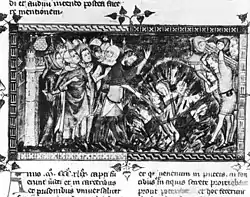Persecution of Jews during the Black Death
The Black Death persecutions and massacres were a series of violent attacks on Jewish communities falsely blamed for outbreaks of the Black Death in Europe from 1348 to 1351.
| Part of a series on |
| Antisemitism |
|---|
 |
|
|

History of persecutions
The official church policy at the time was to protect Jews because Jesus was Jewish. In practice, Jews were often targets of Christian loathing.[1] As the plague swept across Europe in the mid-14th century, annihilating nearly half the population, people had little scientific understanding of the disease and were looking for an explanation.
Jews were often taken as scapegoats and accusations spread that they had caused the disease by deliberately poisoning wells.[2][3] This is likely because they were affected less than other people,[4][5] since many Jews chose not to use the common wells of towns and cities.[1] Jews were also sometimes coerced through torture to confess to poisoning wells.[1]
The first massacres directly related to the plague took place in April 1348 in Toulon, Provence where the Jewish quarter was sacked, and forty Jews were murdered in their homes; the next occurred in Barcelona.[6] In 1349, massacres and persecution spread across Europe, including the Erfurt massacre, the Basel massacre, massacres in Aragon, and Flanders.[7][8] 2,000 Jews were burnt alive on 14 February 1349 in the "Valentine's Day" Strasbourg massacre, where the plague had not yet affected the city. While the ashes smouldered, Christian residents of Strasbourg sifted through and collected the valuable possessions of Jews not burnt by the fires.[9][10] Many hundreds of Jewish communities were destroyed in this period. Within the 510 Jewish communities destroyed in this period, some members killed themselves to avoid the persecutions.[11] In the spring of 1349 the Jewish community in Frankfurt am Main was annihilated. This was followed by the destruction of Jewish communities in Mainz and Cologne. The 3,000 strong Jewish population of Mainz initially defended themselves and managed to hold off the Christian attackers. But the Christians managed to overwhelm the Jewish ghetto in the end and killed all of its Jews.[9]
At Speyer, Jewish corpses were disposed in wine casks and cast into the Rhine. By the close of 1349 the worst of the pogroms had ended in Rhineland. But around this time the massacres of Jews started rising near the Hansa townships of the Baltic Coast and in Eastern Europe. By 1351 there had been 350 incidents of anti-Jewish pogroms and 60 major and 150 minor Jewish communities had been exterminated. All of this caused the eastward movement of Northern Europe's Jewry to Poland and Lithuania, where they remained for the next six centuries. King Casimir III of Poland enthusiastically gave refuge and protection to the Jews. This is consistent with his previous edicts vis-a-vis Jews. On 9 October 1334, Casimir confirmed the privileges granted to Jews in 1264 by Bolesław V the Chaste. Under penalty of death, he prohibited the kidnapping of Jewish children for the purpose of enforced Christian baptism, and he inflicted heavy punishment for the desecration of Jewish cemeteries. The king had therefore been previously well-disposed to Jews.[12] He was also interested in tapping the economic potential of the Jews.[13]
Perceived Jewish immunity
There are many possible reasons why Jews were accused to be the cause for the plague. One reason was because there was a general sense of anti-Semitism in the 14th century.[4] Jews were also isolated in the ghettos, which meant in some places that Jews were less affected.[14][15] Additionally, there are many Jewish laws that promote cleanliness: a Jew must wash his or her hands before eating bread and after using the bathroom, it was customary for Jews to bathe once a week before the Sabbath, a corpse must be washed before burial, and so on.[5]
Government responses
In many cities the civil authorities either did little to protect the Jewish communities or actually abetted the rioters.[16]
Pope Clement VI (the French-born Benedictine, Pierre Roger) tried to protect the Jewish communities, issuing two papal bulls in 1348, on 6 July and 26 September, saying that those who blamed the plague on the Jews had been "seduced by that liar, the Devil". He went on to emphasize that “It cannot be true that the Jews, by such a heinous crime, are the cause or occasion of the plague, because through many parts of the world the same plague, by the hidden judgment of God, has afflicted and afflicts the Jews themselves and many other races who have never lived alongside them.”[17] He urged clergy to take action to protect Jews and offered them papal protection in the city of Avignon. In this, Clement was aided by the research of his personal physician Guy de Chauliac, who argued from his own treatment of the infected that the Jews were not to blame.[18]
Clement's efforts were in part undone by the newly elected Charles IV, Holy Roman Emperor making property of Jews killed in riots forfeit, giving local authorities a financial incentive to turn a blind eye.[19]
Aftermath
As the plague waned in 1350, so did the violence against Jewish communities. In 1351, the plague and the immediate persecution was over, though the background level of persecution and discrimination remained. Ziegler (1998) comments that "there was nothing unique about the massacres".[20] 20 years after the Black Death the Brussels massacre (1370) wiped out the Belgian Jewish community.[21]
Jewish tales of the Black Death in the early modern period
Though told for nearly 350 years, there were no written accounts of the Black Death through Jewish tales until 1696, by Yiftah Yosef ben Naftali Hirts Segal Manzpach in the Mayse Nissim. Yuzpa Shammes, as he frequently was referred to, was a scribe and shammash of the Worms community for several decades. His accounts intend to show that the Jews were not idle but that they took action against inevitably becoming the scapegoat. Despite Yuzpa's assertion that the Jews fought against the massacres, there are contradicting accounts that claim that there was no evidence of "armed resistance".[22] These contradicting tales display the effect of oral tradition being manipulated to fit certain circumstances.
See also
References
- Diane Zahler (2009). The Black Death. Twenty-First Century Books. pp. 64–. ISBN 978-0-8225-9076-7.
- Anna Foa (2000). The Jews of Europe After the Black Death p. 146 "There were several reasons for this, including, it has been suggested, the observance of laws of hygiene tied to ritual practices and a lower incidence of alcoholism and venereal disease"
- Richard S. Levy (2005). Antisemitism p. 763 "Panic emerged again during the scourge of the Black Death in 1348, when widespread terror prompted a revival of the well poisoning charge. In areas where Jews appeared to die of the plague in fewer numbers than Christians, possibly because of better hygiene and greater isolation, lower mortality rates provided evidence of Jewish guilt."
- "Blaming the Jews for the Black Death Plague". www.sixmillioncrucifixions.com. Retrieved 2016-06-09.
- "The Black Death". www.jewishhistory.org. Retrieved 2016-06-09.
- Anna Foa (2003).The Jews of Europe after the black death . p. 13 "This was the context in which the Plague made its appearance in 1348. The Black Death The Plague was not unknown in ... The first massacres took place in April 1348 in Toulon, where the Jewish quarter was raided and forty Jews were murdered in their homes. Shortly afterward, violence broke out in Barcelona and in other Catalan cities."
- Codex Judaica: chronological index of Jewish history; p. 203 Máttis Kantor (2005). "1349 The Black Death massacres swept across Europe. ... The Jews were savagely attacked and massacred, by sometimes hysterical mobs—normal social order had ..."
- John Marshall (2006). John Locke, Toleration and Early Enlightenment Culture; p. 376 "The period of the Black Death saw the massacre of Jews across Germany, and in Aragon, and Flanders",
- Robert S. Gottfried (11 May 2010). Black Death. Simon and Schuster. pp. 74–. ISBN 978-1-4391-1846-7.
- See Stéphane Barry and Norbert Gualde, «La plus grande épidémie de l'histoire» ("The greatest epidemic in history"), in L'Histoire magazine, n° 310, June 2006, p. 47 (in French)
- Durant, Will. "The Renaissance" Simon and Schuster (1953), pp. 730–731, ISBN 0-671-61600-5
- "In Poland, a Jewish Revival Thrives—Minus Jews". The New York Times. 12 July 2007. Probably about 70 percent of the world's European Jews, or Ashkenazi, can trace their ancestry to Poland — thanks to a 14th-century king, Casimir III, the Great, who drew Jewish settlers from across Europe with his vow to protect them as "people of the king"
- Robert S. Gottfried (11 May 2010). Black Death. Simon and Schuster. pp. 74–. ISBN 978-1-4391-1846-7.
He had a Jewish mistress and seemed well-disposed in general to Jews. Perhaps too he was anxious to have the commercial skills which some of the immigrants could offer.
- Pasachoff, Naomi E.; Littman, Robert J. (2005). A Concise History of the Jewish People. Lanham: Rowman & Littlefield. p. 154. ISBN 0-7425-4365-X.
However, Jews regularly ritually washed and bathed, and their abodes were slightly cleaner than their Christian neighbors'. Consequently, when the rat and the flea brought the Black Death, Jews, with better hygiene, suffered less severely ...
- Joseph P Byrne (2012). Encyclopedia of the Black Death Volume 1. p. 15 "Anti-Semitism and AntI-Jewish Violence before the Black Death .. Their attention to personal hygiene and diet, their forms of worship, and cycles of holidays were off-puttingly different."
- Howard N. Lupovitch Jews and Judaism in world history p92—2009 "In May 1349, the city fathers of Brandenburg passed a law a priori condemning Jews of well poisoning: Should it become evident and proved by reliable men that the Jews have caused or will cause in the future the death of Christians,..."
- Simonsohn, Shlomo (1991). Apostolic See and the Jews. Toronto: Pontifical Institute of Mediaeval Studies, Vol. 1: Documents, 492. p. 1404. ISBN 9780888441096.
- Getz, Faye (1998). "Book review: Inventarium sive Chirurgia Magna. Vol. 1, Text". Bulletin of the History of Medicine. 72 (3): 533–535.
- Howard N. Lupovitch Jews and Judaism in world history p. 92 2009 "On July 6, 1349, Pope Clement tried to curb anti-Jewish violence by issuing a papal bull. Its effectiveness was limited by the Holy Roman Emperor Charles IV, who made arrangements for the disposal of Jewish property in the event of a ..."
- Philip Ziegler (1998). The Black Death "The persecution of the Jews waned with the Black Death itself; by 1351 all was over. Save for the horrific circumstances of the plague which provided the incentive and the background, there was nothing unique about the massacres."
- The Shengold Jewish Encyclopedia Mordecai Schreiber (2011). "In 1370, after the Black Death, the brutal Brussels Massacre wiped out the Belgian Jewish community"
- Die Chronik des Mathias von Neuenburg, 1955. "While a Christian chronicler reports that during the pogrom of March 1, 1349, the beleaguered Jews of Worms set fire to their own houses, as may have happened elsewhere, there is no evidence of armed resistance."
Further reading
- Winkler, Albert (2007). "The Approach of the Black Death in Switzerland and the Persecution of Jews, 1348-1349," Swiss American Historical Society Review, vol. 43 (2007), no. 3, pp. 4-23.
- Winkler, Albert (2005). "The Medieval Holocaust: The Approach of the Plague and the Destruction of Jews in Germany, 1348-1349," Federation of East European Family History Societies, vol. 13 (2005), pp. 6-24.